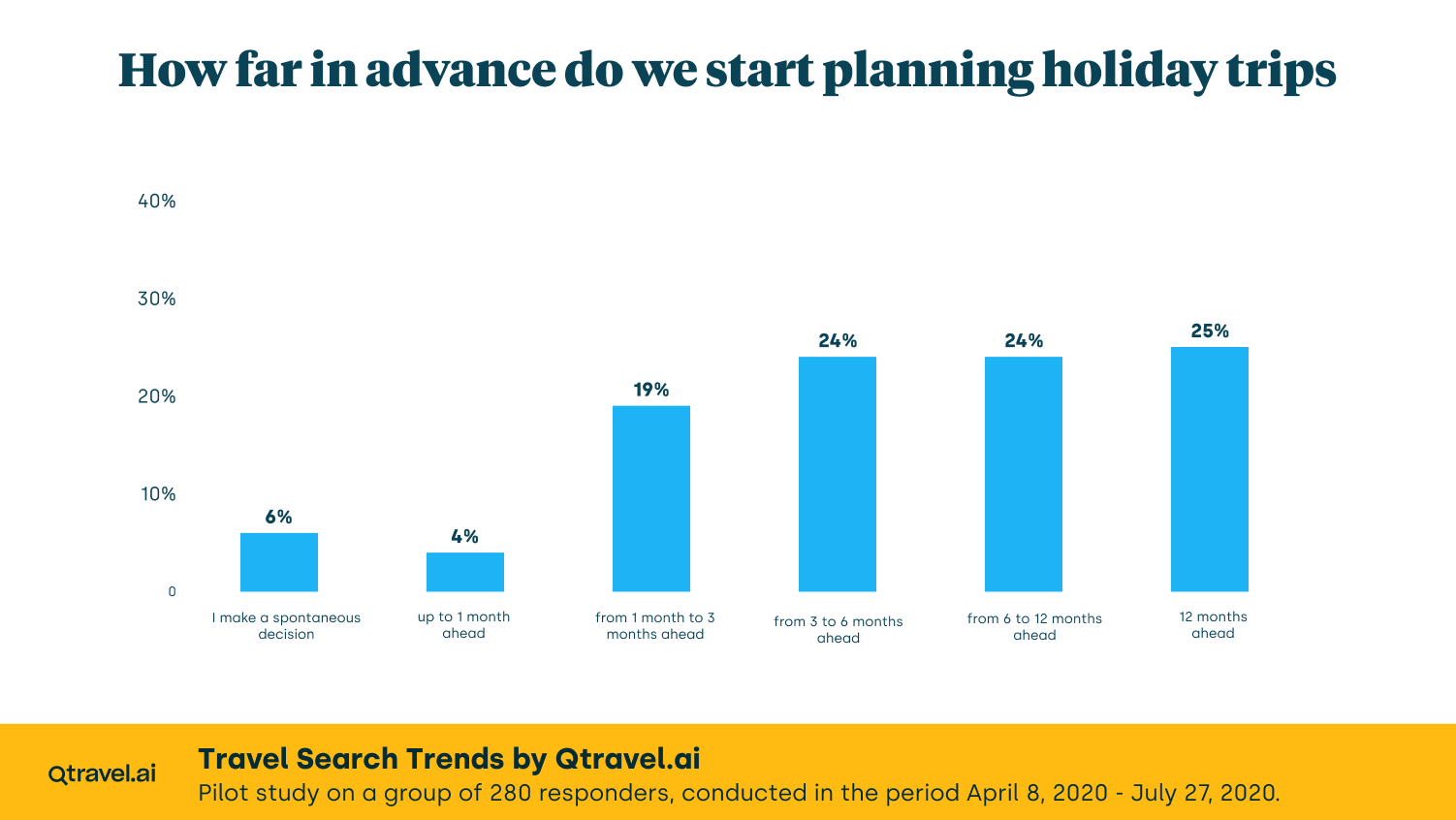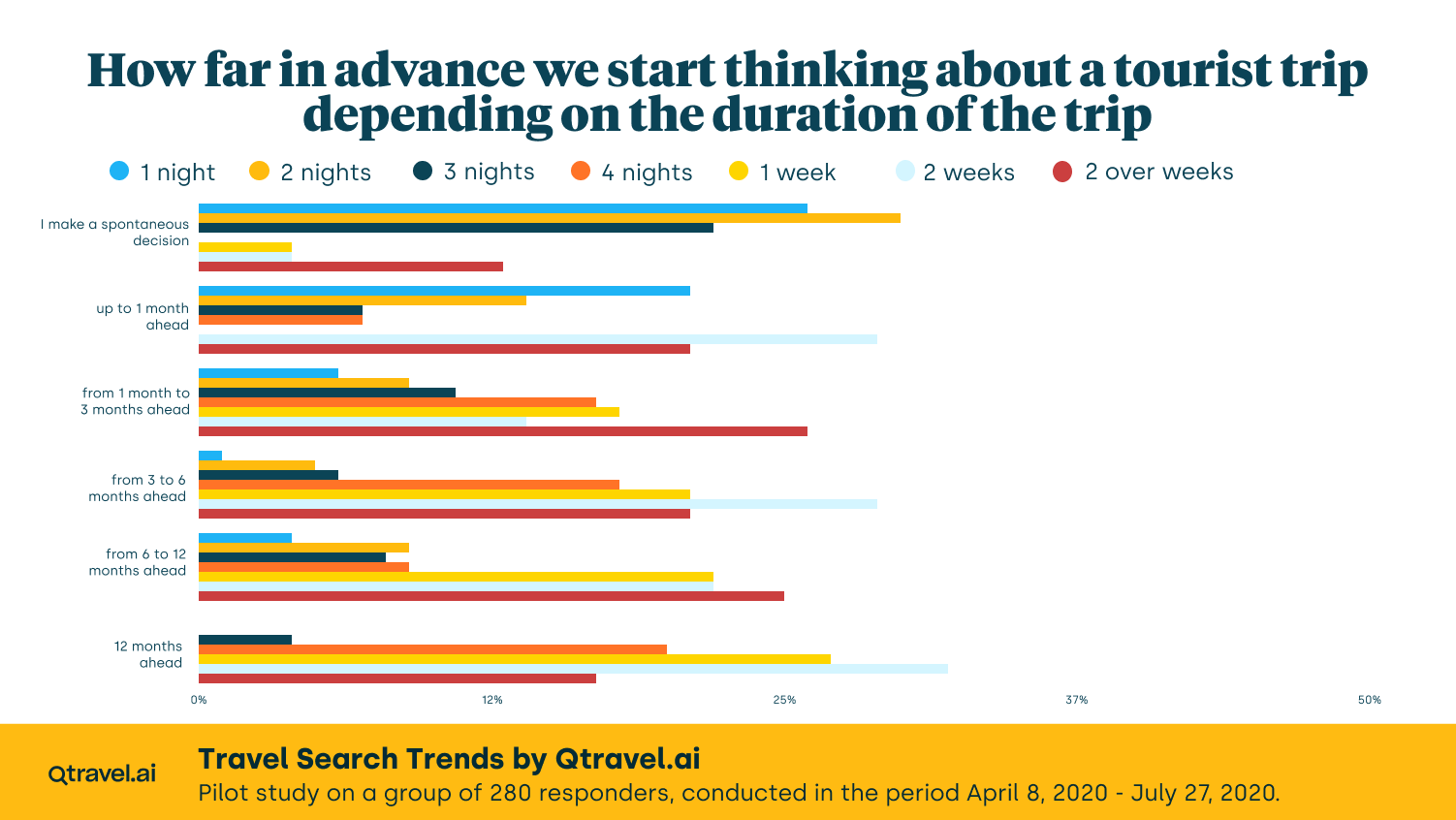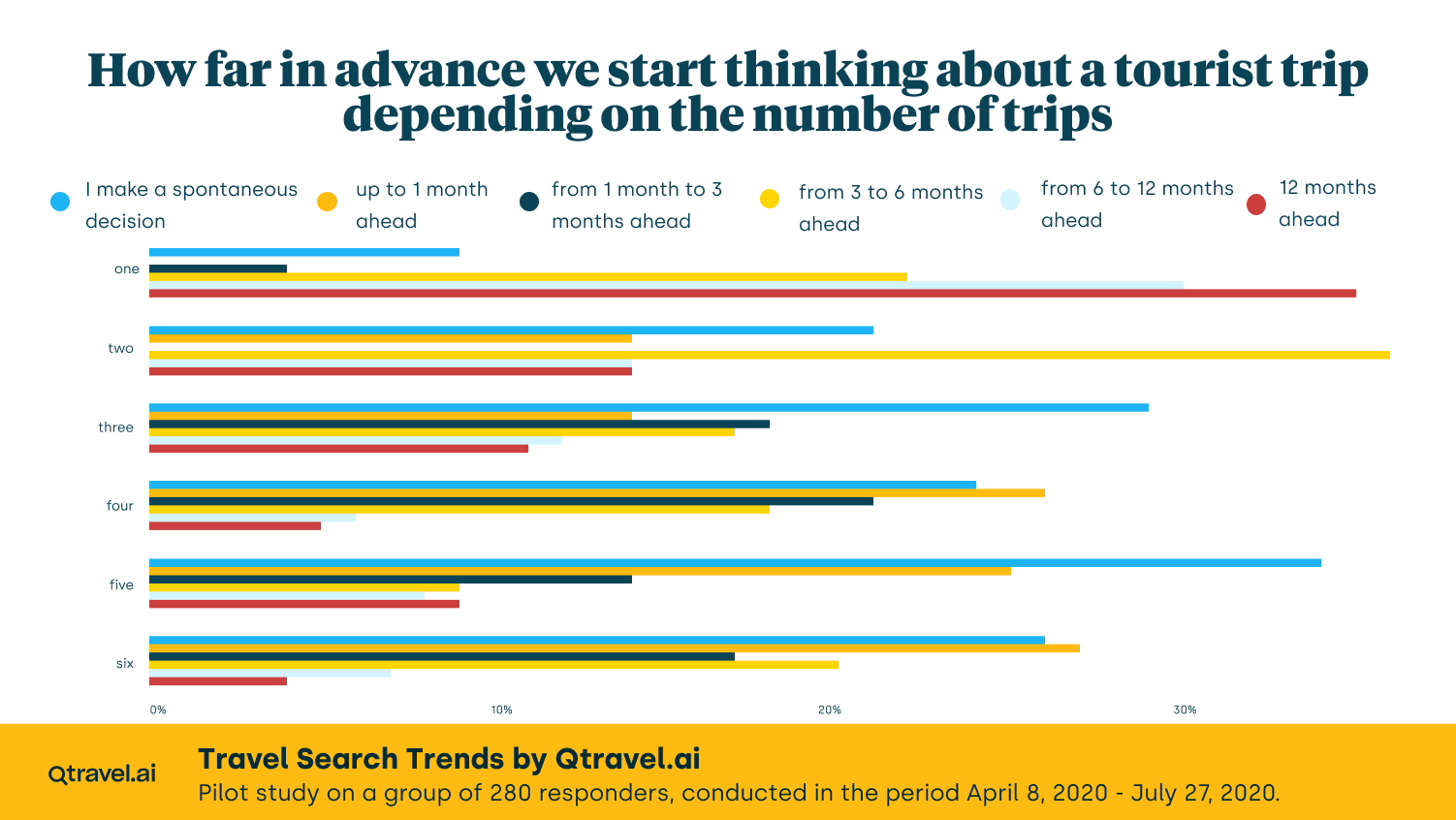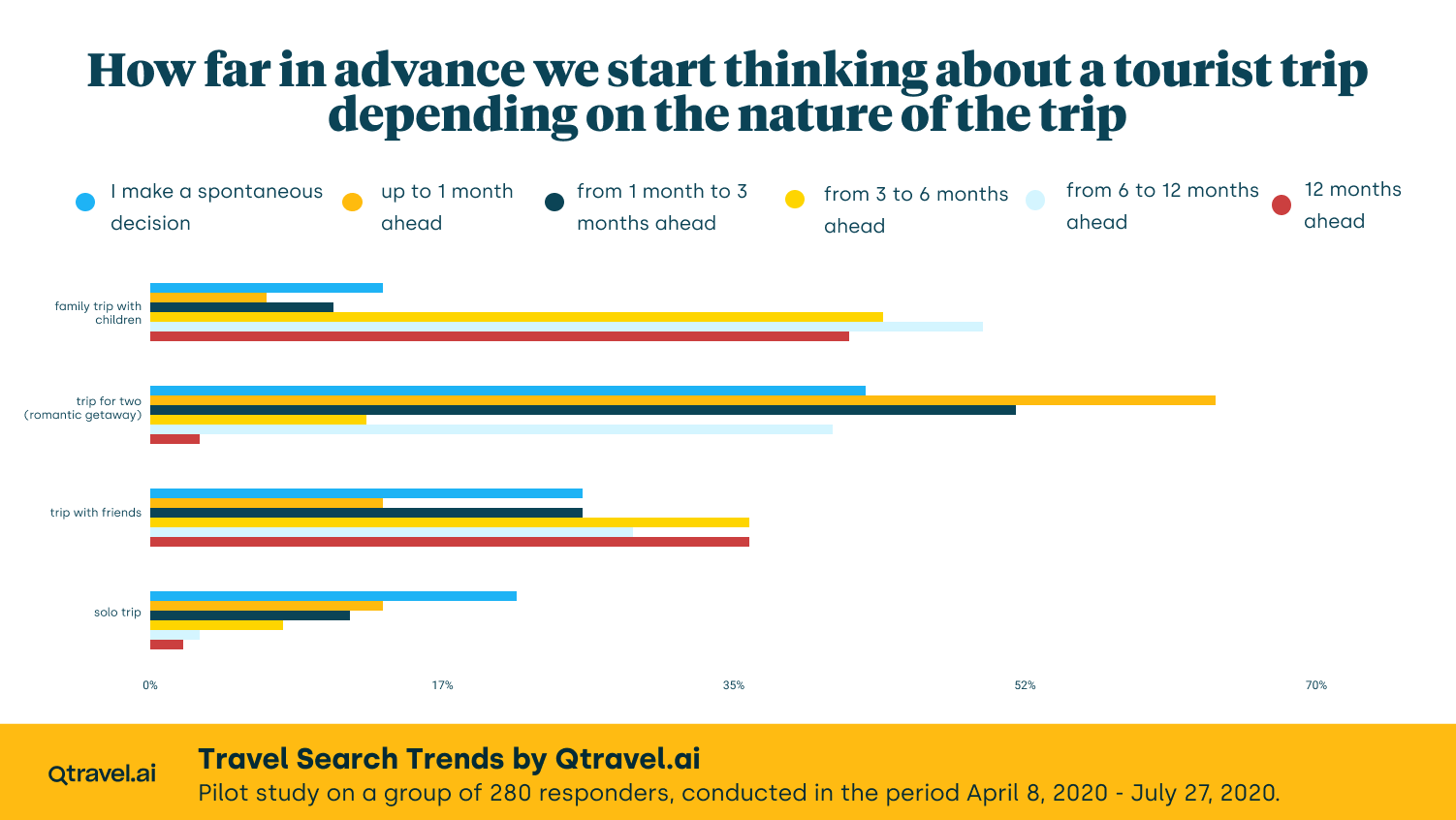We have already characterized foreign travel by Poles in accordance with various criteria. So far, on the basis of the survey described in Travel Search Trends 2020. Part 1 – characteristics of the respondents onducted by the Qtravel agency, we have characterized the respondents in accordance with basic demographic features (gender, age, place of residence, education, occupational situation, and income level). In subsequent episodes of the series, we also analysed the characteristics of the trips undertaken by Poles, including the frequency of trips per year, the number of trips by gender, and the correlation of trip frequency with the level of earnings, the number of overseas/domestic trips, and the length of tourist stays (by income group, gender, and education).
From the point of view of package holiday organisers, the criteria (described in Travel Search Trends 2020. Part 5 – Poles travelling abroad) for the choice of holiday destination, the choice of means of transport, and the choice of accommodation, were also important. This time we will take a look at how, and how much in advance, holidaymakers plan their holiday trips. This time we will take a look at how, and how much in advance, holidaymakers plan their holiday trips. This issue is all the more important from the perspective of tour operators and agencies, as this advance allows them to make better predictions of demand, and manage tourist flows. It is not without reason that first minute travel has started appearing in the offers. Meanwhile, not all tourists are willing or able to make plans well in advance, and the COVID-19 pandemic has further taught us to be very cautious when it comes to planning.
Figure 1 shows how often we are inclined to make decisions that are very spontaneous or, quite the contrary, are given a long consideration. Some of the respondents chose several answers depending on the nature of their trip, which will be discussed shortly.

Among the indications made by the respondents, there is a clear tendency to make holiday plans well in advance – in the group of 281 respondents most people admitted that they start making holiday plans even a year ahead (90 indications), and certainly from 3 to 6 months ahead (87 indications) or from 6 to 12 months ahead (76 indications). Slightly fewer responses (66) were given to the option ‘from a month to 3 months before’, while much fewer respondents indicated a tendency to make spontaneous trips(only 23 indications) and a short (less than a month) time of planning a trip (14 indications).
Of course, it is necessary to clarify what ‘making plans’ actually means: for some, it is just a non-committal wish to return to a place visited before, or an awakened appetite to explore the world. For others, these will be major decisions about when and how to organize the trip. In both cases, however, tour operators should be aware that holiday planning is not seasonal: one can start planning the next holiday trip during the currently ongoing stay, or in the middle of the year, and with a ski trip booked, one may start considering different summer holiday options at the same time. A tour operator who assumes that only the industry prepares for the season months in advance risks losing customers if he fails to notice that tourists do exactly the same. This observation also shows how important first minute offers can be – they are a great response to the buying habits of those who have a preference for a long planning process.
Of course, how far ahead we start thinking about the trip depends on many factors, above all including the length of the planned stay and the distance from the place of permanent residence, as well as the frequency of trips during the year. As a rule, the more distant the trip (in the geographical sense), the further in advance it is planned, which is quite clearly illustrated by Figure 2. This is owing to the fact that long-distance travel is usually longer (as already mentioned in our series) Travel Search Trends 2020. Part 4 – Poles travelling abroad, more elaborate in the cognitive sense, and therefore requires longer preparation and a more careful selection of available offers. This principle also works the other way around: if we plan a trip in advance, we are more likely to choose a distant destination that can make our dreams come true. Economic considerations also play a role: longer notice allows us to accumulate the resources necessary to finance more distant and more expensive trips.

The frequency of trips also has a significant impact on how far in advance we think about travel. The more trips we take throughout the year, the more often we can afford to have shorter planning periods and even travel completely spontaneously. As can be seen in Figure 3, the most frequent indications of a long trip planning period are for those who take 1 or 2 trips per year. In the case of respondents who declare multiple trips (4 trips during the year), the time of planning ahead shortened significantly: the number of people who plan half a year or a year ahead of the departure decreases, while the number of those who make the decision spontaneously or within a month before the planned trip increases. The highest percentage of people willing to organise spontaneous trips concerns those who travel 5 or more times a year, which results partly from organisational, but also economic issues (a greater number of trips is correlated with greater financial possibilities) and finally the purpose of the trip (by nature, business trips are organised less in advance than leisure stays). It is worth noting, however, that even in the group of respondents who undertake 5 or more trips per year there is a certain balance in numbers between those who declare they plan to travel at least half a year in advance. This is most often the case for long family trips (one or two weeks).

In part 4 of the series Travel Search Trends 2020. Part 4 – Poles travelling abroad we discussed the results of a survey conducted by the Qtravel agency which showed that Poles who use the services of travel agencies most often organise family trips with children in this way, slightly less often trips with friends or trips for two, and extremely rarely solo trips (alone). This distribution is worth analysing in the context of how far in advance we start thinking about organizing the trip (see Figure 4).
It is not surprising that trips with children are planned well in advance – tourists usually look for special conditions of stay, catering, availability of childcare, animation activities, variety of possible ways of spending their time, etc. Not every resort has equally developed facilities, so planning such trips a year in advance (53 responses) or at least 3-6 months in advance (38 indications) seems to be an obvious practice. However, even in this group one can find respondents who chose answers ‘up to a month in advance’ and even ‘spontaneous trips’, which may be dictated by a sudden change of family plans and availability of last minute offers.
Spontaneous trips and trips organised with very little notice (up to 1 month) were most often declared by respondents who organised a trip for two. However, it should be kept in mind that in this group, willingness to use the services of travel agencies is generally lower than in the group of respondents who organise family trips or travel with a group of friends. However, from the perspective of travel agencies, there are two challenges: firstly, how to increase the interest of people who plan romantic trips in the services of the agency; secondly, how to encourage this group of customers to plan (and, above all, book) such trips further in advance.

The survey was completed during the first period of the outbreak of the COVID-19 pandemic in Poland, so it is difficult to determine what Poles’ attitudes will be towards planning tourist trips in the future. The level of uncertainty we have experienced over the past 2 seasons in the travel arena has made both planning and booking decisions significantly more difficult. The fear of cancellation is not conducive to the stabilisation of demand and thus poses a serious risk of disruptions on the part of the tourism market.
However, owing to the importance of sales planning in the activities of travel agencies, it is worth taking into account the results of the presented research in order to gain additional arguments during sales talks to build trust among customers and tame the fear of uncertainty, which will probably accompany us for a long time in the realities of the tourism market.
We encourage you to read the rest of the articles in this series:
- Part 1: Profile of the respondents.
- Part 2: How often do tourists travel during the year?
- Part 3: Do we like long holiday stays in Poland?
- Part 4: Poles travelling abroad part 1.
- Part 5: Poles travelling abroad part 2.
- Part 6: How far in advance do we plan tourist trips?
- Part 7: How far in advance do we plan tourist trips? – the income factor.
- Part 8: Flexibility in holiday travel planning.
- Part 9: Frequency of travel versus flexibility in travel planning.
- Part 10: Gender versus flexibility in travel planning.
